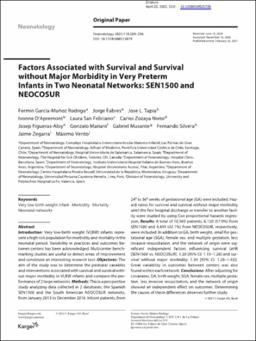| dc.description.abstract | Abstract
Introduction: Very low-birth weight (VLBW) infants represent a high-risk population for morbidity and mortality in the neonatal period. Variability in practices and outcomes between centers has been acknowledged. Multicenter benchmarking studies are useful to detect areas of improvement and constitute an interesting research tool.
Objectives: The aim of the study was to determine the perinatal variables and interventions associated with survival and survival without major morbidity in VLBW infants and compare the performance of 2 large networks.
Methods: This is a prospective study analyzing data collected in 2 databases, the Spanish SEN1500 and the South American NEOCOSUR networks, from January 2013 to December 2016. Inborn patients, from 240 to 306 weeks of gestational age (GA) were included. Hazard ratios for survival and survival without major morbidity until the first hospital discharge or transfer to another facility were studied by using Cox proportional hazards regression.
Results: A total of 10,565 patients, 6,120 (57.9%) from SEN1500 and 4,445 (42.1%) from NEOCOSUR, respectively, were included. In addition to GA, birth weight, small for gestational age (SGA), female sex, and multiple gestation, less invasive resuscitation, and the network of origin were significant independent factors influencing survival (aHR [SEN1500 vs. NEOCOSUR]: 1.20 [95% CI: 1.15-1.26] and survival without major morbidity: 1.34 [95% CI: 1.26-1.43]). Great variability in outcomes between centers was also found within each network.
Conclusions: After adjusting for covariates, GA, birth weight, SGA, female sex, multiple gestation, less invasive resuscitation, and the network of origin showed an independent effect on outcomes. Determining the causes of these differences deserves further study.
Keywords: Morbidity; Mortality; Neonatal networks; Very low-birth weight infant.
© 2021 S. Karger AG, Basel. | es |


